Everything You Need to Know About Georgette’s History, Care, Types, and Sustainability
Quick Answer
Georgette is a lightweight, semi-sheer fabric with a distinctive crinkled texture and beautiful drape. Created from tightly twisted yarns in opposite directions (S-twist and Z-twist), it was named after French dressmaker Georgette de la Plante in the early 1900s. Available in both pure silk and synthetic versions, georgette is loved for its bouncy feel, breathability, and ability to hold dyes well. It’s perfect for summer dresses, evening gowns, sarees, and blouses.
Table of Contents
- What is Georgette Fabric?
- The History of Georgette
- Key Characteristics and Properties
- Types of Georgette Fabric
- How Georgette is Made
- Georgette vs. Other Fabrics
- Sustainability and Environmental Impact
- Fashion Applications and Uses
- How to Identify Real Silk Georgette
- Complete Care Guide
- Sewing with Georgette
- Price Guide and Where to Buy
- Frequently Asked Questions
- Conclusion
What is Georgette Fabric?
Georgette is a type of crepe fabric that belongs to the family of lightweight, breathable textiles. What makes it special is its slightly puckered surface and bouncy texture, created through a unique weaving process using highly twisted yarns.
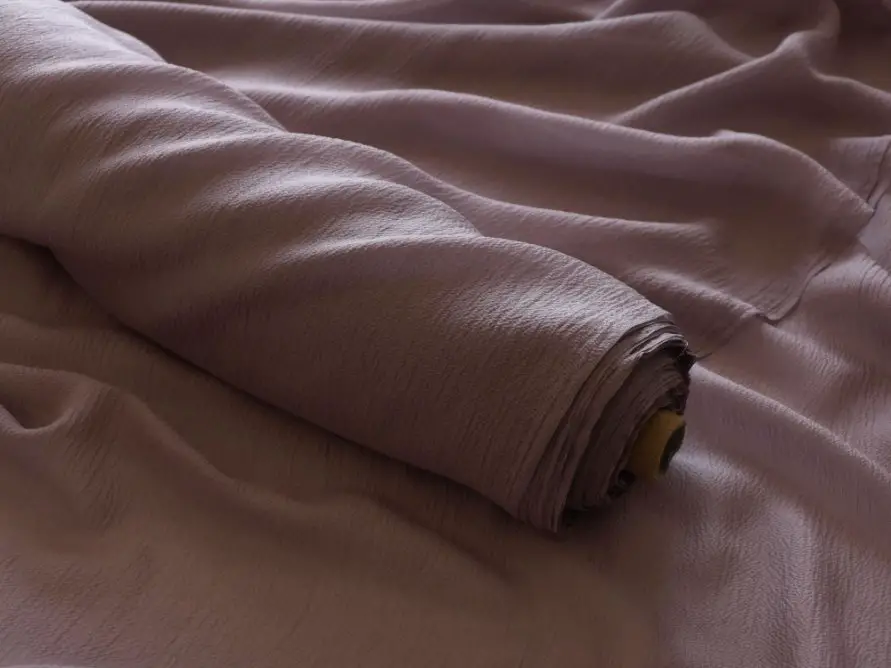
Close-up of crepe georgette fabric roll highlighting its fine texture and natural drape
The fabric gets its name from Madame Georgette de la Plante, a French dressmaker who introduced this elegant material in the early 20th century. She wanted to create something that had the luxury look of chiffon but with more body and less sheerness, making it more practical for everyday wear.
What Kind of Fabric is Georgette?
Georgette is a woven fabric that can be made from different materials. Traditional georgette uses pure silk, which gives it a luxurious feel and natural sheen. Modern versions often use synthetic fibers like polyester, rayon, or viscose, making it more affordable and easier to care for.
The defining feature of georgette is how it’s woven. The yarns are twisted very tightly in alternating directions (called S-twist and Z-twist). When these twisted yarns relax after weaving, they create the fabric’s signature crinkled texture. This texture gives georgette its slightly rough, grainy feel and bouncy drape.
The Fascinating History of Georgette Fabric
The story of georgette begins in Paris during the early 1900s, a time when fashion was going through big changes. Women were moving away from heavy, structured Victorian clothing toward lighter, more flowing styles.
Madame Georgette de la Plante saw an opportunity. She created a fabric that offered the dreamy, romantic look of chiffon but wasn’t quite as see-through. This made it perfect for women who wanted elegance without being too revealing.
The Golden Era: 1920s-1930s
Georgette really took off during the Art Deco period of the 1920s and 1930s. The fabric’s flowing nature matched perfectly with the loose, dropped-waist dresses that were popular at the time. Fashion icon Coco Chanel became a fan of georgette, using it in her designs and helping to make it a must-have fabric for fashionable women.
During this era, georgette was made exclusively from silk and was considered a luxury material that only wealthy women could afford.
Mid-Century Changes
The 1950s and 1960s brought big changes to georgette production. The development of synthetic fibers meant that manufacturers could create georgette using polyester and rayon. This made the fabric much more affordable and accessible to everyday people.
The 1960s bohemian fashion movement loved georgette for its free-flowing, romantic qualities. It became a favorite for hippie-style dresses and blouses.
Georgette Today
Modern georgette continues to be popular in fashion, especially for:
- Bridal and evening wear
- Indian sarees and ethnic clothing
- Summer dresses and blouses
- Scarves and accessories
Today, you can find georgette in both its original silk form and in synthetic versions, giving shoppers options at every price point.
Key Characteristics and Properties
Understanding what makes georgette unique helps you decide if it’s the right fabric for your needs. Here are the main features:
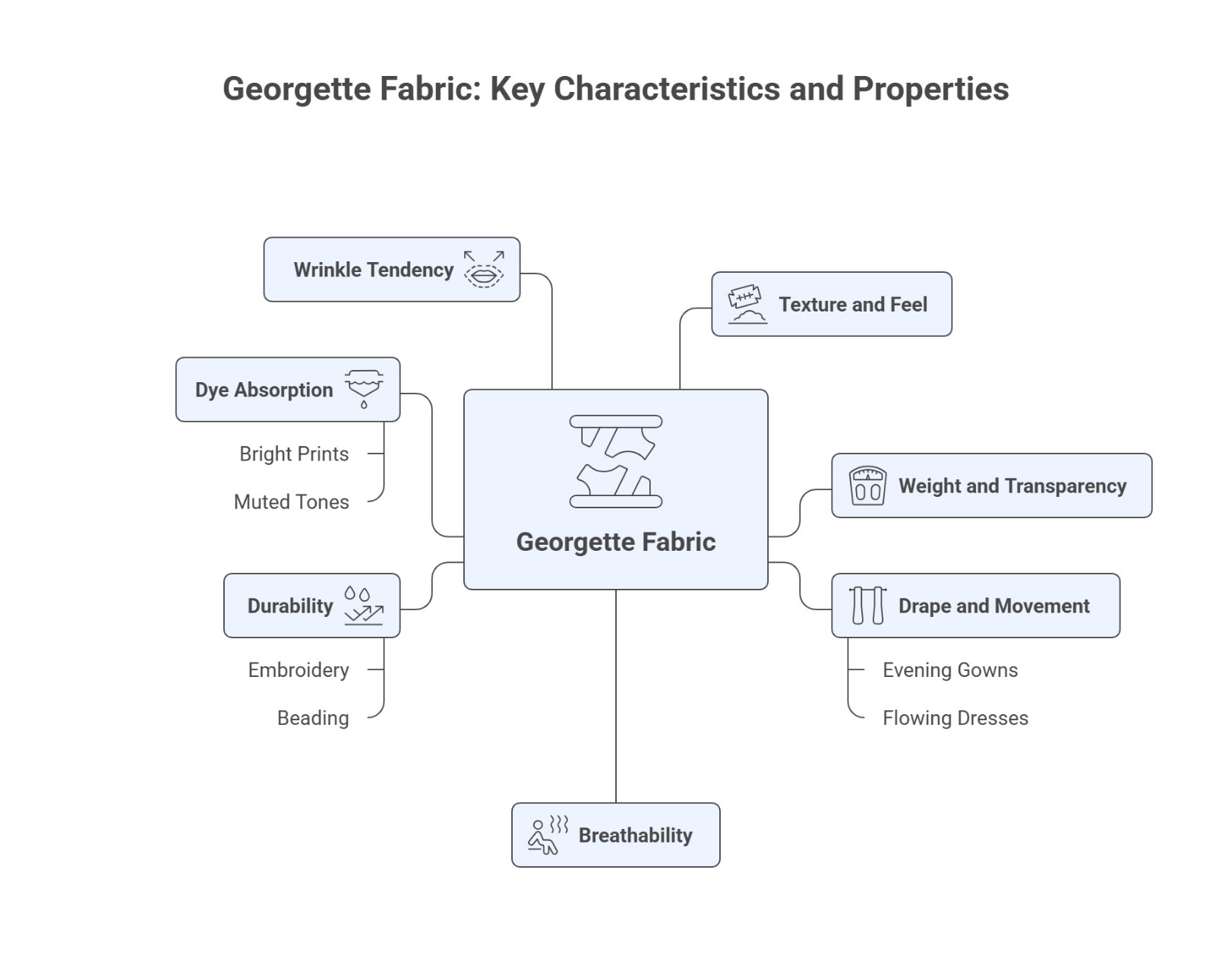
Georgette Fabric Properties – Understanding its texture, weight, and durability
Texture and Feel
What does georgette fabric feel like? When you touch georgette, you’ll notice it has a slightly grainy, pebbled texture. It’s not as smooth as satin or as rough as burlap. The surface has a subtle “crinkle” that you can both see and feel. This texture comes from those tightly twisted yarns we talked about earlier.
Silk georgette feels softer and has a slight waxy quality, while polyester georgette feels a bit more crisp and structured.
Weight and Transparency
Is georgette fabric heavy? No, georgette is a lightweight fabric. It’s heavier than chiffon but still flows and drapes beautifully. The fabric is semi-sheer, meaning you can see through it a bit, but it’s not as transparent as chiffon. This makes it more practical for garments where you don’t want everything showing through.
Drape and Movement
One of georgette’s best qualities is how it drapes. The fabric flows like water, clinging gently to the body without being tight. It has a natural bounce or spring to it, which means it moves beautifully when you walk. This fluid drape is why designers love using it for evening gowns and flowing dresses.
Breathability
Is georgette good for summer? Yes! Georgette is an excellent summer fabric, especially when made from silk. The lightweight nature and loose weave allow air to flow through, keeping you cool in hot weather. However, polyester georgette isn’t as breathable as silk, so it might not be as comfortable in extreme heat.
Durability
Despite being lightweight and delicate-looking, georgette is surprisingly strong. It’s more durable than chiffon, which means it can handle embroidery, beading, and other embellishments without tearing easily. However, it can still snag, so you need to be careful with jewelry and rough surfaces.
Dye Absorption
Georgette holds dyes really well. The fabric can be dyed in deep, rich colors or soft pastels with great results. This is why you’ll find georgette in everything from bright, bold prints to subtle, muted tones.
Wrinkle Tendency
Does georgette fabric wrinkle? This depends on the type. Silk georgette is fairly wrinkle-resistant thanks to the twisted yarn structure. Polyester georgette is even more wrinkle-resistant. However, both types can develop some wrinkles if packed tightly or stored improperly. The good news is that georgette wrinkles usually hang out naturally or can be easily steamed.
Does georgette need ironing? Not usually. The crinkled texture actually hides minor wrinkles. If you do need to freshen up your georgette garment, steaming is better than ironing. If you must iron, use low heat and place a pressing cloth between the iron and the fabric.
Types of Georgette Fabric
Not all georgette is created equal. There are several types, each with its own characteristics and best uses.
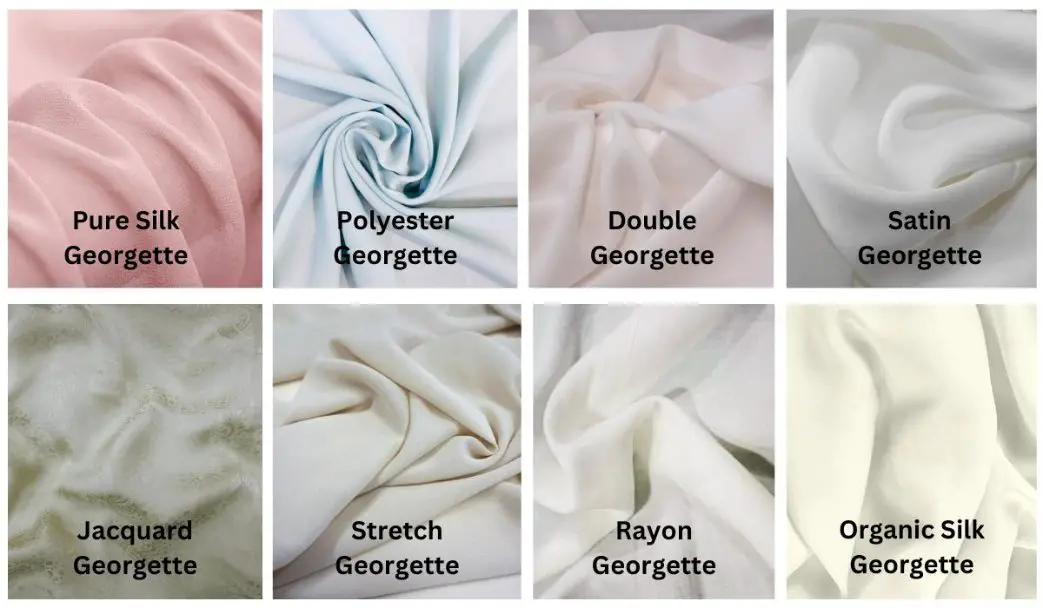
Different Types of Georgette Fabric – From pure silk to synthetic blends
Pure Silk Georgette
Is georgette real silk? It can be. Pure silk georgette is made from 100% silk fibers harvested from silkworm cocoons. This is the original, most luxurious version of the fabric.
Features:
- Softest, most comfortable feel
- Natural temperature regulation
- Beautiful natural sheen
- Most expensive option
- Requires delicate care
- Biodegradable and natural
Learn more about different silk types, including mulberry silk and eri silk, which can be used to make georgette.
Polyester Georgette (Faux Georgette)
What is 100% georgette? When you see “100% georgette” on a label, it usually means 100% polyester georgette. This is the most common and affordable type found in stores today.
Features:
- Much more affordable than silk
- More durable and less prone to snagging
- Machine washable (check label first)
- Less breathable than silk
- Can create static electricity
- Not biodegradable
Double Georgette
Double georgette is woven with two sets of twisted yarns, making it thicker and less transparent than regular georgette. It still maintains the characteristic drape but has more body and structure.
Best for: Garments that need more coverage, structured dresses, tailored blouses
Satin Georgette
This hybrid fabric combines georgette’s crinkled texture with a satin weave on one side. The result is a fabric that has a subtle sheen on the face and a matte georgette texture on the back.
Best for: Formal wear, evening gowns, garments where you want a bit of shine
Jacquard Georgette
Jacquard georgette features woven patterns created during the weaving process. These patterns are not printed but built into the fabric structure, creating a textured design.
Best for: Statement pieces, ethnic wear, decorative clothing
Stretch Georgette
This modern version includes a small percentage of elastane or spandex (usually 3-5%), giving the fabric stretch and recovery. It still looks like traditional georgette but moves with your body better.
Best for: Fitted garments, comfortable everyday wear, body-hugging styles
Viscose/Rayon Georgette
Which is better viscose or georgette? This is actually a trick question because viscose can be used to make georgette. Viscose georgette is a semi-synthetic option made from plant cellulose (usually wood pulp). It offers a middle ground between silk and polyester.
Features:
- More breathable than polyester
- More affordable than silk
- Drapes beautifully like silk
- More sustainable than pure synthetic options
- Can shrink if not cared for properly
Organic Silk Georgette (GOTS Certified)
This is the most sustainable option for those wanting real silk. GOTS (Global Organic Textile Standard) certification means the silk was produced using organic methods with strict environmental and social standards.
Features:
- No harmful pesticides or chemicals
- Ethical production standards
- Better for the environment
- More expensive than regular silk
- Limited availability
How Georgette Fabric is Made
Understanding how georgette is created helps you appreciate this special fabric even more.
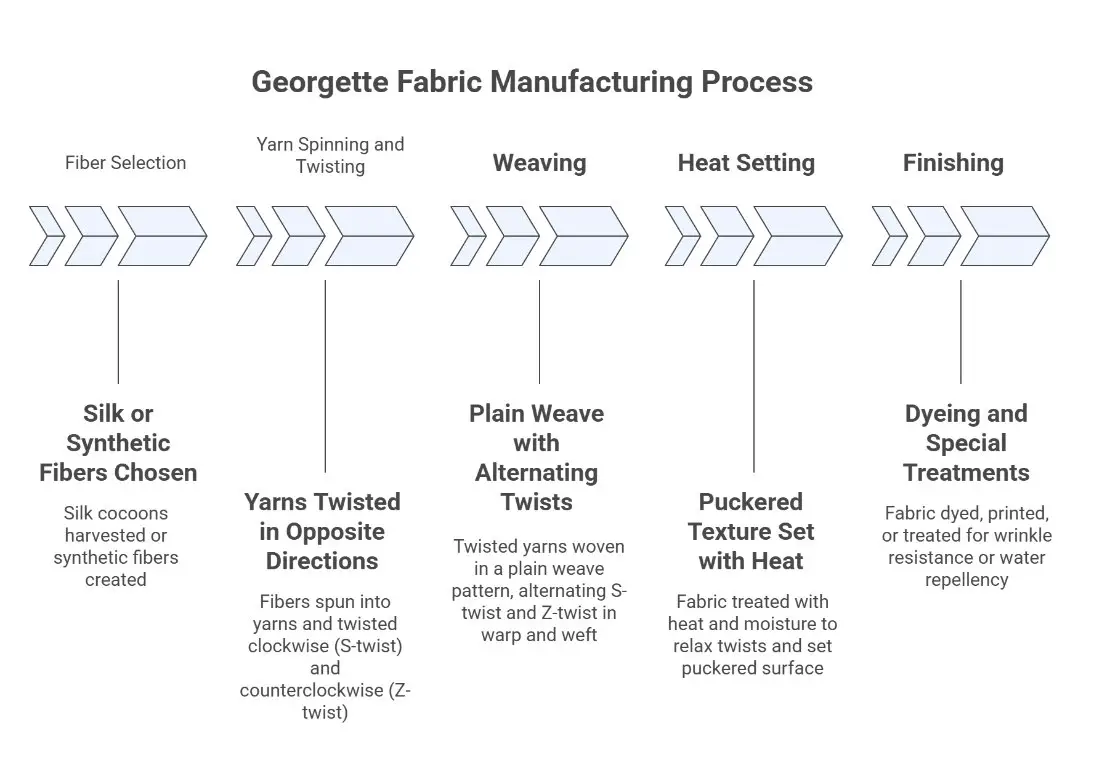
The Georgette Fabric Manufacturing Process – From silk fibers to textured fabric
Step 1: Fiber Selection
For silk georgette, the process starts with harvesting silk from silkworm cocoons. The cocoons are carefully collected, and the silk fibers are extracted by soaking them in hot water. These continuous filaments can be several hundred meters long from a single cocoon.
For synthetic georgette, polyester or other fibers are created through chemical processes and formed into continuous filaments.
Step 2: Yarn Spinning and Twisting
This is where georgette gets its unique character. The fibers are spun into yarns, which are then twisted very tightly. The key is that the yarns are twisted in opposite directions:
- S-twist: Twisted clockwise
- Z-twist: Twisted counterclockwise
This high twist (usually 10-20 turns per inch) is what creates the crinkled texture later.
Step 3: Weaving
The twisted yarns are woven using a plain weave pattern, alternating S-twist and Z-twist yarns in both the warp (lengthwise) and weft (crosswise) directions. This creates a balanced fabric where the opposing twists create tension.
Step 4: Heat Setting
After weaving, the fabric is treated with heat and sometimes moisture. This allows the twisted yarns to relax slightly, creating the characteristic puckered surface. The heat also helps set the shape so the fabric maintains its crinkled texture.
Step 5: Finishing
The fabric may be dyed, printed, or left in its natural color. Some georgette receives additional treatments to improve specific properties like wrinkle resistance or water repellency.
Georgette vs. Other Fabrics
People often confuse georgette with similar lightweight fabrics. Here’s how they compare:
Georgette vs. Chiffon
Which is better georgette or chiffon? Neither is “better” – they each have different strengths. Let’s break down the differences:

Georgette Fabric vs. Chiffon Fabric – Understanding the texture, weight, and flow differences
| Feature | Georgette | Chiffon |
|---|---|---|
| Texture | Crinkled, grainy, pebbled surface | Smooth, flat, slightly rough feel |
| Weight | Heavier (8-12 momme) | Lighter (6-8 momme) |
| Sheerness | Semi-sheer, more opaque | Very sheer, more transparent |
| Appearance | Matte finish, no shine | Subtle shimmer and sheen |
| Durability | More durable, handles embellishment better | More delicate, frays easily |
| Drape | Fluid with body, clings gently | Ultra-fluid, floats more |
| Best Colors | Bold, vibrant colors (orange, purple, emerald) | Pastels and light shades (baby pink, sky blue) |
| Best Uses | Blouses, structured dresses, sarees | Overlays, scarves, flowing gowns |
| Price | Moderate to high | Moderate to high |
Choose georgette if: You want more coverage, plan to add beading or embroidery, need a fabric that’s easier to work with, or prefer bold colors.
Choose chiffon if: You want maximum flow and ethereal quality, need a very lightweight overlay, or prefer softer, lighter colors.
Georgette vs. Organza
Which is better, organza or georgette? Again, it depends on what you’re making. These fabrics are quite different:
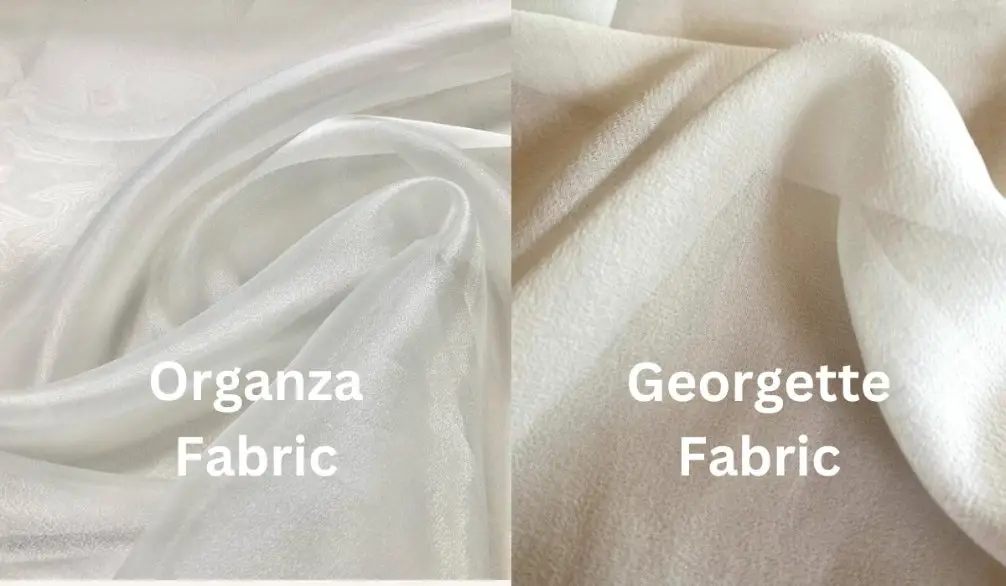
Georgette Fabric vs. Organza Fabric – Comparing texture, sheen, and stiffness
| Feature | Georgette | Organza |
|---|---|---|
| Texture | Soft, crinkled, slightly rough | Crisp, smooth, stiff |
| Drape | Soft and flowing | Structured and holds shape |
| Feel | Supple, moves with body | Stiff, stands away from body |
| Transparency | Semi-sheer | Sheer to very sheer |
| Weight | 8-12 momme | 4-6 momme |
| Finish | Matte | Can be shiny or matte |
| Best Uses | Flowing dresses, blouses, sarees | Ball gowns, veils, structured garments |
| Sewing Difficulty | Moderate to difficult | Moderate |
Learn more about organza fabric and when to use it in your projects.
Is organza out of fashion? Not at all! While fashion trends come and go, both georgette and organza remain timeless fabrics. Organza is still widely used in bridal wear, ball gowns, and formal occasions. The choice between them should be based on your project needs, not trends.
Georgette vs. Crepe
Are crepe and georgette the same? Not exactly, but they’re related. Georgette is actually a type of crepe fabric. All georgette is crepe, but not all crepe is georgette.

Georgette Fabric vs. Crepe Fabric – Analyzing the difference in weave and texture
| Feature | Georgette | Crepe (General) |
|---|---|---|
| Texture | Crinkled, pebbled, grainy | Can range from flat to heavily puckered |
| Weight | Lightweight (8-12 momme) | Can be light to heavy weight |
| Transparency | Semi-sheer | Usually opaque |
| Drape | Very fluid, bouncy | Good drape but heavier fall |
| Surface | Matte, dull finish | Can be matte or have slight sheen |
| Structure | Soft, flowing | More body and structure |
The main difference is that georgette is specifically a lightweight, sheer version of crepe, while other crepe fabrics can be heavier and more opaque.
Cotton vs. Georgette
Which is better, cotton or georgette? These are very different fabrics, so the answer depends on your needs:
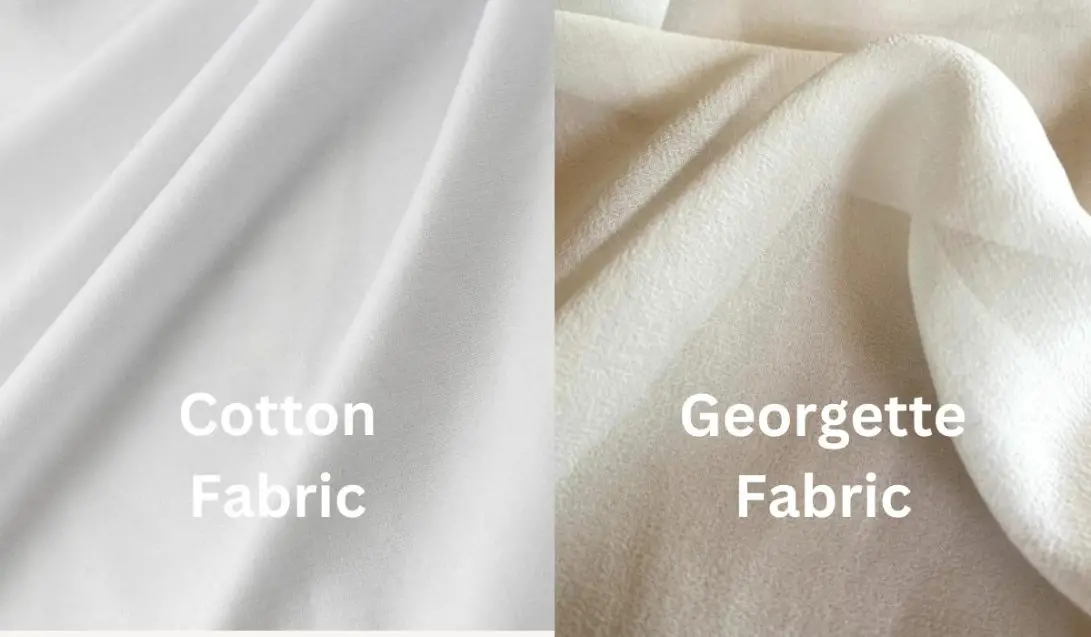
Cotton Fabric vs. Georgette Fabric – Comparing texture, weave, and feel for fashion and dressmaking
Choose cotton if: You want something casual, machine-washable, highly absorbent, and durable for everyday wear. Cotton fabric is perfect for basics and casual clothing.
Choose georgette if: You want elegance, drape, special occasion wear, or something lightweight with a beautiful flow. Georgette is better for formal and dressy occasions.
Interestingly, there’s also cotton georgette, which combines the breathability of cotton with the georgette weave structure. This creates a more affordable, washable option that’s still quite elegant.
Sustainability and Environmental Impact
With growing concern about fashion’s impact on the planet, it’s worth understanding how different types of georgette affect the environment.
Silk Georgette Environmental Impact
The Good:
- Biodegradable: Silk georgette will naturally decompose, unlike synthetic fabrics
- Natural material: Made from renewable silkworm cocoons
- No microplastics: Doesn’t shed harmful plastic particles into water systems
- Long-lasting: High-quality silk georgette can last for decades with proper care
The Challenges:
- Water intensive: Silk production requires large amounts of water for sericulture
- Energy use: The process of harvesting and processing silk is energy-intensive
- Chemical treatments: Some silk georgette may be treated with chemicals during processing
- Ethical concerns: Traditional silk production involves killing silkworms, which some people object to
Better options: Look for GOTS-certified organic silk georgette or peace silk (Ahimsa silk) where the silkworms complete their life cycle before the cocoons are harvested.
Polyester Georgette Environmental Impact
The Challenges:
- Petroleum-based: Made from non-renewable fossil fuels
- Microplastic pollution: Sheds tiny plastic fibers when washed, which enter water systems and harm marine life
- Not biodegradable: Will sit in landfills for hundreds of years
- Energy-intensive production: Manufacturing polyester requires significant energy
The Good:
- Durability: Lasts a long time, reducing need for replacement
- Lower price: Makes georgette accessible to more people
- Resource efficiency: Uses less water than silk production
Better option: Look for recycled polyester georgette, which is made from post-consumer plastic bottles and waste. This reduces the need for new petroleum extraction.
Sustainable Alternatives
Several emerging options offer more sustainable georgette-like fabrics:
- Organic cotton georgette: Made from organically grown cotton using the georgette weave. It’s breathable, biodegradable, and doesn’t use harmful pesticides.
- Peace silk georgette: Made from silk where the moths are allowed to emerge naturally before the cocoons are processed.
- Bamboo-silk blend georgette: Combines the sustainability of bamboo with the luxury of silk.
- Biodegradable polyester: New innovations are creating polyester that can break down, though this is still in early stages.
- Recycled georgette: Some manufacturers are now recycling old georgette garments into new fabric.
Making Sustainable Choices
Here’s how to choose more sustainable georgette:
- Buy quality over quantity: One well-made silk georgette piece that lasts 10 years is better than five cheap synthetic ones that last 2 years each
- Look for certifications: GOTS (organic), OEKO-TEX (free from harmful chemicals), or GRS (recycled content)
- Care properly: Proper care extends the life of your georgette, reducing waste
- Buy secondhand: Vintage georgette pieces are often high quality and don’t create new environmental impact
- Support ethical brands: Research companies that prioritize sustainability and ethical production
Fashion Applications and Uses
Georgette’s unique properties make it perfect for many different types of clothing and accessories.

Elegant evening gown made from georgette fabric showing its graceful drape and movement
Evening and Formal Wear
Georgette is a top choice for special occasions because of its elegant drape and slightly dressy appearance. You’ll find it in:
- Evening gowns: The fluid drape creates beautiful silhouettes that move gracefully
- Cocktail dresses: Less formal than heavy satin but dressier than cotton
- Mother-of-the-bride dresses: Offers sophistication without being too flashy
Bridal Wear
Georgette has become increasingly popular in bridal fashion:
- Wedding gowns: Especially for destination or beach weddings where lighter fabrics are needed
- Bridesmaid dresses: Drapes beautifully on different body types
- Bridal veils: Offers more coverage than tulle while still being light
- Reception dresses: More comfortable for dancing and celebrating
Indian and Ethnic Wear
Georgette is huge in South Asian fashion:
- Sarees: The way georgette layers and drapes makes it perfect for the multiple folds of a saree. It’s especially popular for wedding and festival sarees
- Salwar kameez: The flowing fabric is ideal for the long kurtas (tunics)
- Lehengas: Creates beautiful volume in skirts without being heavy
- Dupattas: The scarf/shawl worn with traditional outfits
Everyday Fashion
Georgette isn’t just for special occasions:
- Blouses and tops: The fabric provides structure while still being feminine
- Summer dresses: Lightweight and breathable for hot weather
- Skirts: Creates beautiful movement when walking
- Tunics: Drapes nicely over pants or leggings
Accessories
- Scarves: Georgette’s drape makes it perfect for neck scarves and shawls
- Wraps and stoles: Adds elegance to an outfit
- Hair accessories: Some designers use georgette for headbands and hair ties
Home Decor
Georgette isn’t just for clothing:
- Curtains and drapes: The sheer quality allows light through while providing privacy
- Table overlays: Adds elegance to special occasion table settings
- Decorative pillows: Creates texture in home decor
- Event decorations: Used for wedding and party decorations
Is Georgette a Winter Fabric?
While georgette is most popular in summer, it’s actually versatile enough for year-round wear. In winter, you can:
- Layer it over warmer pieces
- Use heavier versions like double georgette
- Combine it with jackets and cardigans
- Choose darker, richer colors for a winter feel
The key is layering. Georgette on its own won’t keep you warm, but it works beautifully as part of a winter outfit.
How to Identify Real Silk Georgette
How to identify pure georgette? With so many synthetic versions on the market, it’s important to know how to spot the real thing. Here are reliable tests:
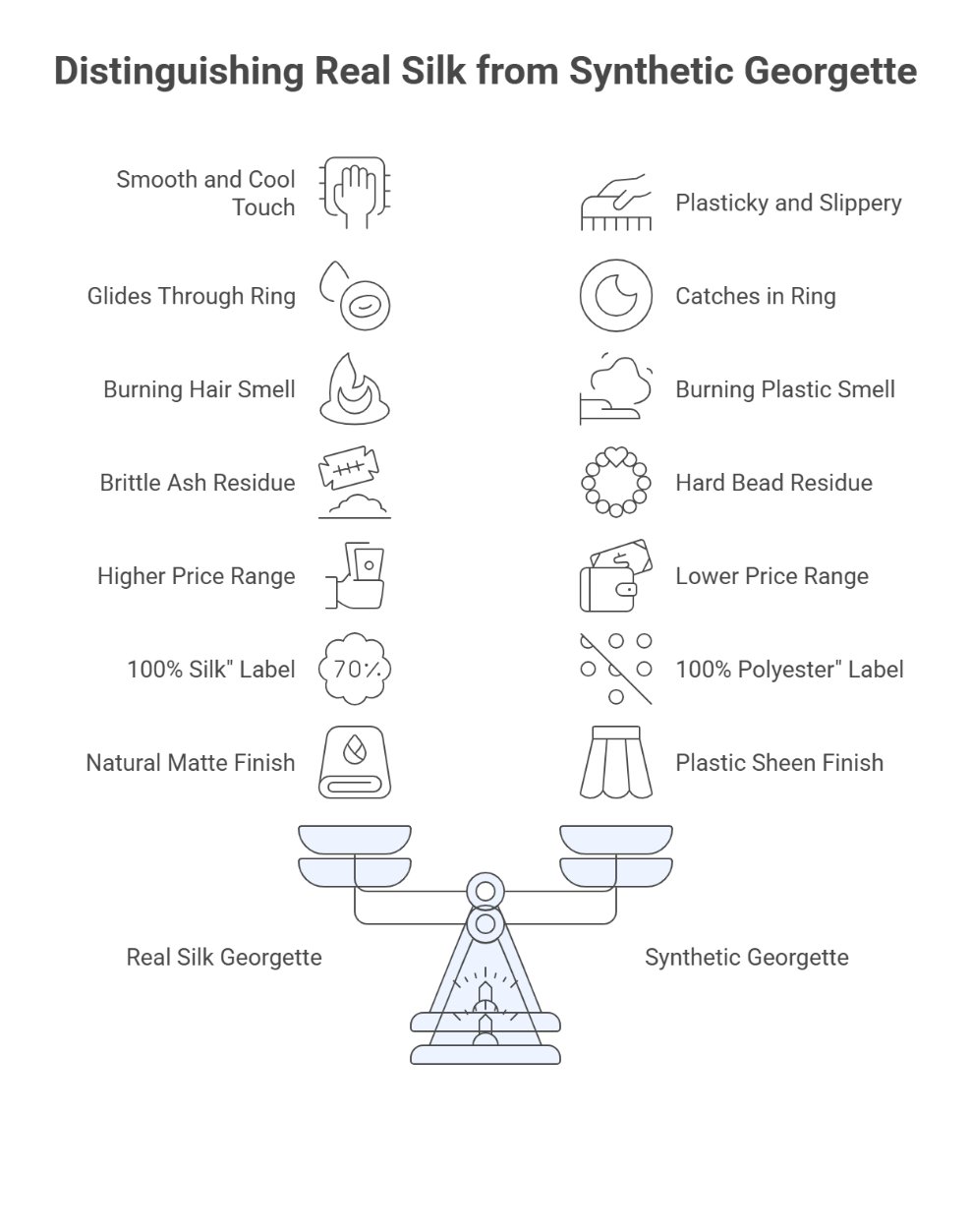
How to Identify Real Silk Georgette – Key differences from synthetic versions
The Touch Test
Real silk georgette has a distinctive feel. While it has the signature crinkled texture, the silk itself should feel smooth and slightly cool to the touch. It has a subtle waxy quality. Synthetic georgette feels more plasticky and doesn’t have that cool, smooth touch.
Rub the fabric between your fingers. Silk will warm up quickly and feel luxurious. Polyester stays cooler and feels more slippery.
The Ring Test
This is one of the easiest tests for silk georgette:
- Take a small piece of the fabric (or use a corner if you haven’t bought it yet)
- Try to pull it through a jewelry ring
- Real silk georgette should glide through easily without snagging
- Synthetic georgette might catch or be harder to pull through
This works because silk fibers are very fine and smooth, even when twisted into the georgette texture.
The Burn Test
Warning: This test destroys a small piece of fabric, so only do it if you already own the item or can get a swatch from the seller.
Cut a Small Sample
Take a tiny piece from an inconspicuous area, about the size of a thread
Burn Carefully
Hold it with tweezers over a non-flammable surface and light it with a match or lighter
Observe the Smell
Real silk: Smells like burning hair or feathers (protein smell)
Synthetic: Smells like burning plastic or chemicals
Check the Residue
Real silk: Leaves behind dark, brittle ash that crushes easily
Synthetic: Melts into hard beads or plastic-like residue
The Price Check
Is georgette a cheap material? It depends. Pure silk georgette is definitely not cheap. If you find georgette fabric or clothing at very low prices, it’s almost certainly synthetic.
As a rough guide:
- Polyester georgette: $5-15 per yard
- Viscose georgette: $10-20 per yard
- Silk georgette: $20-60+ per yard
- Organic silk georgette: $40-100+ per yard
For finished garments, a real silk georgette dress might cost $150-500+, while polyester versions might be $30-100.
The Label Check
Always read the fiber content label. In most countries, manufacturers are required to accurately list what the fabric is made from. Look for:
- “100% Silk” = Real silk georgette
- “100% Polyester” = Synthetic georgette
- “Silk/Polyester blend” = Mixed fiber georgette
- “100% Viscose” or “Rayon” = Semi-synthetic georgette
Visual Inspection
Look closely at the fabric in good light:
- Real silk georgette: Has irregular slight variations in texture, a natural matte finish, and subtle color depth
- Synthetic georgette: Looks more uniform and perfect, might have a slight plastic sheen, colors can look flatter
Complete Care Guide for Georgette Fabric
Proper care is the difference between georgette that lasts for years and georgette that falls apart after a few wears. Here’s everything you need to know.
Washing Georgette
Can you wash georgette fabric? Yes, but the method depends on the type.
For Silk Georgette
Can you handwash silk georgette? Yes, and this is usually the best method. Here’s how to do it safely:
Prepare Cold Water
Fill a clean basin or sink with cold water (never hot, which can damage silk). Add a small amount of mild detergent made for delicate fabrics or baby shampoo.
Submerge and Soak
Gently place the garment in the water. Swish it around gently to distribute the soap. Let it soak for no more than 5-10 minutes.
Gentle Agitation
Move the garment gently through the water. Don’t rub, twist, or wring. Just let it move naturally in the water.
Rinse Thoroughly
Drain the soapy water and refill with clean cold water. Rinse until all soap is gone (usually 2-3 rinses).
Remove Excess Water
Gently squeeze (never wring!) the water out. Or better yet, lay the garment flat on a clean towel, roll it up, and press gently to absorb water.
Dry Properly
Lay flat on a dry towel away from direct sunlight or heat sources. Reshape while damp and let air dry completely.
Alternative: Dry cleaning is often the safest bet for expensive silk georgette pieces, especially those with embellishments. Look for a cleaner experienced with delicate fabrics.
For Polyester Georgette
Polyester georgette is much easier to care for. Many polyester georgette garments can be machine washed on a gentle cycle, but always check the care label first.
Machine washing tips:
- Use a mesh laundry bag to protect the fabric
- Wash on gentle/delicate cycle with cold water
- Use mild detergent
- Wash with similar colors and fabrics
- Remove immediately after washing to prevent wrinkles
You can also hand wash polyester georgette using the same method as silk. Learn more about caring for polyester fabrics.
Does Georgette Shrink After Washing?
This depends on the fiber content:
- Silk georgette: Can shrink slightly if washed in hot water or dried in a dryer. Stick to cold water and air drying
- Polyester georgette: Very resistant to shrinking
- Viscose/rayon georgette: Most prone to shrinking. Always hand wash in cold water and lay flat to dry
Need help with fabric care? Try our Fabric Care Generator for personalized washing instructions based on your specific georgette type.
Drying Georgette
Never put georgette in the dryer! The heat can damage the fibers, cause shrinking, or melt synthetic versions.
Best drying method:
- Lay flat on a clean, dry towel
- Reshape the garment while it’s still damp
- Keep away from direct sunlight (can fade colors)
- Keep away from heat sources (radiators, heaters)
- Allow to dry completely before storing
Hanging to dry: Only hang georgette if you must. Use padded hangers and hang in a shaded, well-ventilated area. Be aware that hanging might cause the garment to stretch slightly due to the weight of the water.
Ironing and Steaming
Can georgette fabric be ironed? Yes, but with caution. Steaming is usually a better option.
Steaming (Recommended)
Can you steam georgette fabric? Absolutely! This is the safest way to remove wrinkles:
- Hang the garment
- Use a handheld steamer or hang in a steamy bathroom
- Hold the steamer a few inches away from the fabric
- Gently pull the fabric taut as you steam
- Let it dry completely before wearing
Ironing (If Necessary)
If you must iron:
- Use the lowest heat setting (silk/delicate setting)
- Always iron on the wrong side of the fabric
- Place a pressing cloth (a thin cotton cloth) between the iron and the georgette
- Never leave the iron in one spot – keep it moving
- Don’t use steam when ironing silk georgette
- Iron while the fabric is slightly damp for best results
Stain Removal
Act quickly when you get a stain on georgette:
- Blot, don’t rub: Gently blot spills immediately with a clean cloth
- No hot water: Always use cold water for stains
- Test first: Test any stain remover on an inconspicuous area first
- Mild solutions: Use a tiny amount of mild detergent mixed with water
- Professional help: For difficult stains on silk georgette, take it to a professional cleaner
Storage
Proper storage keeps your georgette in great condition:
- Clean before storing: Always wash or dry clean georgette before putting it away. Stains set over time
- Fold, don’t hang: Hanging can cause stretching. Fold loosely with acid-free tissue paper
- Breathable storage: Use cotton garment bags, not plastic
- Cool, dry place: Avoid damp basements or hot attics
- Moth protection: For silk georgette, use cedar blocks or lavender sachets (not mothballs, which can stain)
Sewing with Georgette
Is georgette fabric easy to sew? Honestly, no. Georgette can be challenging, especially for beginners. But with the right techniques and patience, you can create beautiful garments.
Fabric Masterclass: Everything you need to know about sewing with Georgette fabric
Challenges When Sewing Georgette
- Slippery: The fabric shifts and slides easily
- Sheer: All your seams will show through
- Snags easily: Rough hands or surfaces can catch the delicate fibers
- Frays quickly: Edges unravel if not finished properly
- Hard to cut: The fabric moves under scissors
Tips for Sewing Success
Prep Your Fabric
Pre-wash georgette before cutting if you plan to wash the finished garment. This prevents shrinking later. Let it air dry completely.
Use Sharp Tools
Use very sharp scissors or a rotary cutter. Dull blades will snag and pull the fabric. Replace your sewing machine needle with a new, fine needle (size 60/8 or 70/10 for lightweight georgette).
Cutting Technique
Lay georgette on tissue paper or pattern paper before cutting. This stabilizes the fabric and makes cutting easier. Cut both layers together. You can also pin the fabric to your cutting mat or use pattern weights instead of pins.
Stitch Settings
Use a shorter stitch length (2.0-2.5mm) and reduce tension slightly. Test on a scrap piece first. Sew slowly to maintain control.
Thread Choice
Use fine silk thread for silk georgette or quality polyester thread for synthetic georgette. The thread should be as fine as the fabric. Check out our guide to choosing thread for more details.
Seam Finishing
Since georgette is sheer, pay attention to seam finishing. Options include French seams (best for sheer fabric), rolled hems, or serged edges. Learn about French seams and other seam techniques.
Best Projects for Beginners
If you’re new to sewing with georgette, start with these easier projects:
- Simple scarves (minimal seams)
- Loose-fitting tops with minimal structure
- Basic skirts with elastic waistbands
- Overlays for existing garments
Avoid fitted dresses, structured garments, or anything with complicated closures until you’re more comfortable with the fabric.
Check out our beginner’s guide to sewing and easy sewing projects for more ideas.
Price Guide and Where to Buy
Is georgette good quality? It can be, but quality varies widely based on fiber content, construction, and brand.
Fabric Prices (per yard)
Polyester Georgette: $5-15
Viscose/Rayon Georgette: $10-25
Silk-Polyester Blend: $15-30
Silk Georgette: $20-60
Premium Silk Georgette: $40-80
Organic/GOTS Certified Silk: $50-100+
Ready-Made Garment Prices
Polyester Georgette Dress: $30-100
Silk Georgette Blouse: $80-250
Designer Georgette Dress: $200-800+
Georgette Saree (Polyester): $20-80
Georgette Saree (Silk): $100-500+
Where to Buy Georgette
Online Fabric Stores:
- Mood Fabrics (wide selection)
- Fabric.com (affordable options)
- Fashion Fabrics Club (deals on georgette)
- Silk Baron (for high-quality silk georgette)
Local Options:
- Fabric stores in your area (check for sales)
- Indian fabric shops (great for georgette saree fabric)
- Wedding fabric suppliers
For Ready-Made Clothing:
- Department stores (for formal wear)
- Online retailers (check return policies)
- Indian clothing stores (for traditional wear)
- Boutiques specializing in evening wear
What to Look For When Buying
- Feel the fabric: It should be smooth (for silk) or consistent (for synthetic)
- Check the weave: Look for even texture with no thin spots
- Examine edges: They shouldn’t fray excessively when you gently pull a thread
- Test the drape: Hold it up and see how it falls
- Read the label: Make sure you know what you’re getting
- Ask about returns: Especially important when buying online
Pros and Cons of Georgette Fabric
What are the pros and cons of georgette? Here’s an honest assessment to help you decide if it’s right for you.
Pros
- Beautiful drape: Flows elegantly and clings gently to the body
- Versatile: Works for casual, formal, and everything in between
- Breathable: Especially silk georgette keeps you cool in summer
- Lightweight: Comfortable to wear all day
- Takes color well: Can be dyed in vibrant or subtle shades
- Texture hides wrinkles: The crinkled surface doesn’t show every crease
- Bouncy movement: Has a lively quality when you move
- Stronger than chiffon: Can handle embellishments
- Range of options: Available in silk, synthetic, and blends at various price points
- Timeless: Never really goes out of style
Cons
- Snags easily: Rough surfaces and jewelry can catch the fabric
- Requires special care: Silk versions need hand washing or dry cleaning
- Can be expensive: Quality silk georgette is pricey
- Difficult to sew: Not beginner-friendly
- Semi-sheer: May require lining or layering
- Frays easily: Cut edges unravel quickly
- Shows perspiration: Some colors show sweat stains
- Environmental concerns: Synthetic versions shed microplastics
- Not warm: Not suitable as outerwear in cold weather
- Quality varies: Hard to judge quality online
Georgette in 2025: Current Trends
Georgette continues to be popular in fashion, with some exciting trends for 2025:
Bold Prints and Patterns
Large floral prints, abstract patterns, and geometric designs are trending. The way georgette drapes makes these patterns flow beautifully.
Sustainable Focus
More brands are offering organic and recycled georgette options as eco-conscious consumers demand better choices. Check out the latest in 2025 fabric trends.
Monochrome Elegance
Single-color georgette outfits in black, white, or neutral tones are big for minimalist fashion lovers.
Embellishment
Sequins, beads, and embroidery on georgette are popular for special occasions. The fabric is strong enough to support these additions.
Indo-Western Fusion
Combining traditional Indian georgette styles with Western silhouettes is trending, creating unique and modern looks.
Layering
Using georgette as a layering piece over slip dresses or with structured jackets is a popular styling trend.
Frequently Asked Questions
Is georgette better than silk?
This is a confusing question because georgette can BE silk. Georgette refers to how the fabric is woven (with tightly twisted yarns), while silk refers to the fiber used. So you can have silk georgette, which is georgette made from silk fibers. You can also have polyester georgette. If you’re comparing silk georgette to other silk fabrics like charmeuse or dupioni, each has different properties for different uses.
Is georgette wrinkle free?
Georgette is fairly wrinkle-resistant, but not completely wrinkle-free. The crinkled texture helps hide minor wrinkles. Polyester georgette wrinkles less than silk georgette. While it won’t stay perfectly crisp without care, it’s much better than fabrics like linen or cotton that wrinkle easily.
Does georgette wrinkle easily?
No, georgette doesn’t wrinkle as easily as many other fabrics. The twisted yarn structure and textured surface naturally resist wrinkling. However, if you pack it tightly or leave it crumpled for a long time, it will develop creases. The good news is these wrinkles usually hang out with wear or can be easily steamed away.
How to wash georgette clothes at home?
For silk georgette: Hand wash in cold water with mild detergent, gently squeeze (never wring), and lay flat to dry. For polyester georgette: You can machine wash on gentle cycle in cold water using a mesh bag, or hand wash. Always check the care label first. Remove from water promptly and don’t let it sit wet. Never put georgette in the dryer.
Still have questions? Try our Fabric Identification Quiz to test your georgette knowledge!
Conclusion
Georgette is a beautiful, versatile fabric that has been a fashion staple for over 100 years. From its invention by Madame Georgette de la Plante in early 1900s Paris to its continued popularity today, this lightweight fabric with its distinctive crinkled texture has proven its staying power.
Remember These Important Points:
About the Fabric:
- Georgette is defined by its weaving technique (S-twist and Z-twist yarns), not just its fiber content
- It comes in silk, polyester, viscose, and blends, each with different properties and prices
- The fabric weighs between 8-12 momme, making it heavier than chiffon but lighter than crepe
- It’s semi-sheer, breathable, and has a beautiful drape that makes it perfect for flowing garments
Best Uses:
- Evening gowns and formal wear
- Bridal dresses and bridesmaid gowns
- Indian sarees and ethnic clothing
- Summer dresses and blouses
- Scarves and accessories
Care Requirements:
- Silk georgette needs hand washing or dry cleaning
- Polyester georgette is more wash-friendly but still needs gentle care
- Always air dry flat – never use a dryer
- Steam instead of iron when possible
- Store folded with tissue paper in breathable bags
Sustainability Considerations:
- Silk georgette is biodegradable but resource-intensive to produce
- Polyester georgette is more durable but creates microplastic pollution
- Look for GOTS-certified organic silk or recycled polyester for more eco-friendly options
- Buying quality pieces that last is better than cheap fast fashion
Who Should Choose Georgette?
Georgette is perfect for you if:
- You want elegant, flowing garments for special occasions
- You need breathable fabric for warm weather
- You appreciate beautiful drape and movement
- You’re willing to provide proper care for delicate fabrics
- You love the look of sheer fabrics but want more coverage than chiffon
Consider other options if:
- You need something machine-washable for everyday wear
- You want a fabric that’s easy for beginner sewers
- You need something warm for cold weather
- You’re looking for a structured fabric that holds shape
- You want completely opaque coverage without lining
Making the Right Choice
When deciding between silk and synthetic georgette, consider:
- Budget: Silk costs 3-10 times more than polyester
- Use: Special occasions might warrant silk; everyday wear could use polyester
- Care commitment: Be honest about whether you’ll hand wash or pay for dry cleaning
- Environmental values: Both have trade-offs; choose based on your priorities
- Sensitivity: If you have sensitive skin, silk is the safer bet
Final Thoughts
Georgette remains popular after more than a century because it offers something special: the perfect balance of elegance and wearability. It’s dressy enough for a wedding but comfortable enough to wear all day. It’s light and breezy but not see-through. It flows beautifully but isn’t as fragile as chiffon.
Whether you choose silk georgette for a once-in-a-lifetime dress or polyester georgette for everyday wear, you’re choosing a fabric with a rich history and timeless appeal. Take the time to learn proper care, and your georgette pieces can last for years, maybe even becoming heirlooms you pass down.
The key is being informed. Now that you understand what georgette is, how it’s made, how to care for it, and what to look for when buying, you’re ready to make smart decisions about this beautiful fabric.
Whether you’re a fashion lover building your wardrobe, a sewer looking for your next project, or someone interested in sustainable textiles, georgette has something to offer. Give it a try – you might just fall in love with its beautiful drape and timeless elegance.
Want to learn more about other elegant fabrics? Check out our guides on silk fabric, chiffon, and organza to compare your options.
References
- Global Organic Textile Standard (GOTS). Global Standards for Organic Textiles. Accessed November 2025.
- OEKO-TEX®. Standard 100 by OEKO-TEX: Testing for Harmful Substances. Accessed November 2025.
- The Metropolitan Museum of Art. The Costume Institute: History of Textiles in Fashion. Accessed November 2025.
